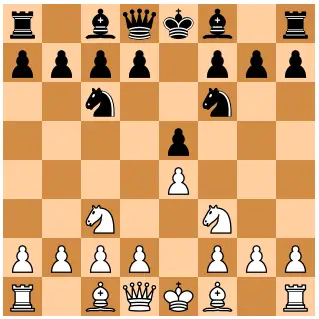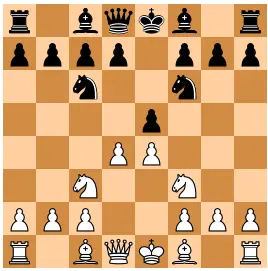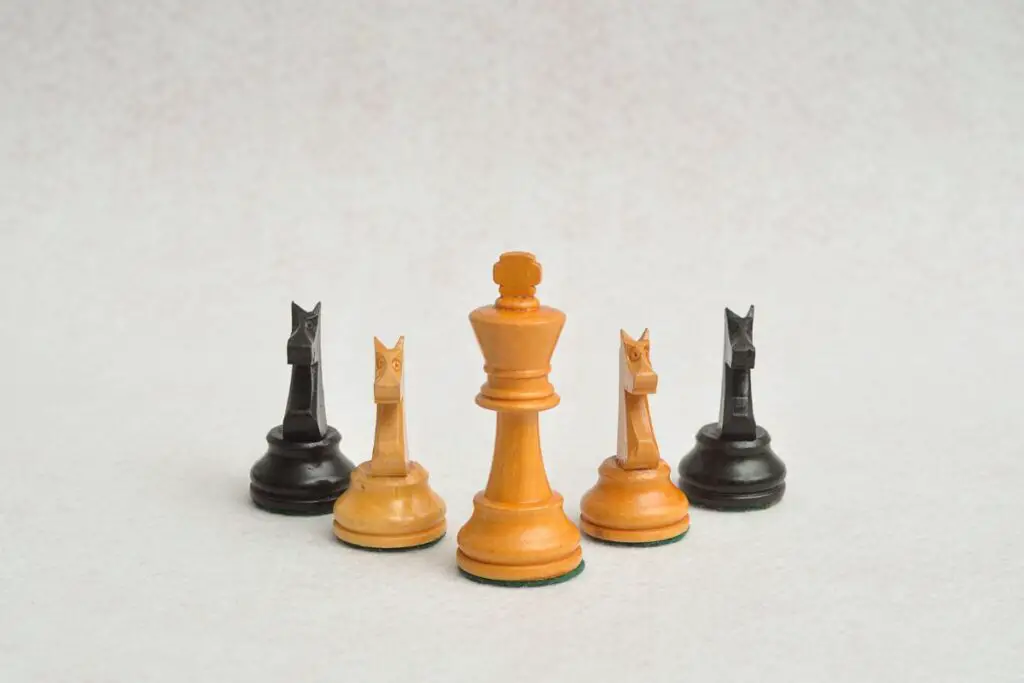The Four Knights Opening stands as a testament to chess’s strategic intricacies, a classic and time-honored gateway to the vast realm of possibilities that the game offers.
With its symmetrical and balanced nature, this opening introduces players to a delicate dance of knights and bishops, where subtle decisions can shape the course of the battle on the 64-square battlefield.
As the knights take their positions before the bishops, a captivating struggle for control, space, and tactical opportunities unfolds.
In this brief exploration, we delve into the essence of the Four Knights Opening, uncovering its historical significance and the fundamental principles it imparts to aspiring chess enthusiasts.
Four Knights Opening Move
1.e4 e5 2.Nf3 Nc6 3.Nc3 Nf6

This is the traditional Four Knights’ Game, where one of the fundamental opening principles beginners are taught is “Knights before bishops.”
Devotees of this principle rigidly adhere to this setup. In this setup, all four knights are developed, leading to a symmetrical position.
Renowned players of the classical era, such as Maroczy, Capablanca, Lasker, Tarrasch, and Rubinstein, often opted for the Symmetrical Variation, playing 4. Bb5 Bb4 5. O-O O-O 6. d3 d6 7. Bg5.
At this point, Black can break the symmetry with 7…Bxc3 (though 7…Bg4 is also a choice, it could be risky due to 8. Bxf6 Qxf6?; opting for 8…gxf6 is better, yet it leaves White with a stronger position due to Black’s weakened kingside). After 7…Bxc3, White responds with 8. bxc3, resulting in a balanced position.
However, alternatives like Rubinstein’s 4…Nd4 and Marshall’s 4…Bc5 introduce more aggressive approaches.
The Scotch Four Knights variation initiates with 4.d4 and can lead to the dynamic Belgrade Gambit after 4…exd4 5.Nd5!?.
This gambit involves intricate tactics, often proceeding with 4…exd4 5. Nd5 Nxe4 6. Bc4 Be7 7. Nxd4 O-O 8. Nb5 Bc5 9. O-O Nxf2 11. Qh5.
Despite Black maintaining a reasonable position, cautious and calculated play becomes necessary.
Scotch Four Knights Game

When White makes the move 4.d4, it sets the stage for the Scotch Four Knights Game. This makes the game more open, and you can get to this setup from the Scotch Game too.
For instance, if we follow the moves 1.e4 e5 2.Nf3 Nc6 3.d4 exd4 4.Nxd4 Nf6 5.Nc3. This kind of setup was seen in the fifth match of the 1996 Deep Blue vs. Garry Kasparov game.
White might go for the Four Knights (3.Nc3) move order instead of the Scotch (3.d4) for a few reasons.
One reason could be to avoid a situation where after 3.d4 exd4 4.Nxd4, Black can choose 4…Bc5 or 4…Qh4.
Another reason might be to prepare for the Belgrade Gambit (1.e4 e5 2.Nf3 Nc6 3.Nc3 Nf6 4.d4 exd4 5.Nd5!?), which can’t be played if we start from the Scotch.
However, it’s important to know that the Belgrade Gambit is not as popular as the more common 5.Nxd4 approach.
Italian Four Knights Game

Another option at this juncture is 4.Bc4, giving rise to the Italian Four Knights Game, also known as the Prussian Four Knights Game.
This line gained popularity during the 1880s. However, it’s worth noting that this variation is considered weaker, as noted by Pinski, and even deemed a clear misstep by IM Larry D. Evans. To maintain the symmetry, Black can respond with 4…Bc5, leading to the more tranquil Giuoco Pianissimo.
A more effective White move order leading to this position involves the Giuoco Piano approach: 1.e4 e5 2.Nf3 Nc6 3.Bc4 Bc5 4.Nc3 Nf6.
This sequence is favored by younger players due to its straightforward and uncomplicated development. Interestingly, Nigel Short effectively employed this line against Antoaneta Stefanova, showcasing its viability in competitive play.
Spanish Variation

White’s most typical choice is 4.Bb5, recognized as the Spanish Variation. This path can also be traversed from the Ruy Lopez, specifically the Berlin Defense. Once 4.Bb5 is played, Black encounters four principal options.
The initial option is 4…Bb4, termed the Double Spanish Variation, a symmetrical approach. For a more assertive stance, Black may select 4…Nd4, known as the Rubinstein Variation.
In this scenario, White refrains from capturing the pawn with 5.Nxe5, as Black regains the pawn, holding the bishop pair advantage, through 5…Qe7 6.Nf3 (6.f4 Nxb5 7.Nxb5 d6) Nxb5 7.Nxb5 Qxe4+ 8.Qe2 Qxe2+ 9.Kxe2 Nd5 10.c4 a6!
Frequently, White counters with 5.Ba4, prompting a gambit-like continuation from Black with 5…Bc5!? 6.Nxe5 0-0 7.Nd3 Bb6 8.e5 Ne8, followed by …d6.
An alternative path, which dissuades several ambitious Black players from pursuing the Rubinstein, involves 5.Nxd4 exd4 6.e5 dxc3 7.exf6 Qxf6 (7…cxd2+? 8.Bxd2 Qxf6 9.0-0 poses risks for Black) 8.dxc3 Qe5+. This often culminates in a swift draw after 9.Qe2 Qxe2+.
The classical move of 4…Bc5 is a viable choice, illustrated in the celebrated game Louis Paulsen–Paul Morphy at the First American Chess Congress in 1857.
In recent times, a novel approach of 4…Bd6!? has been experimented with by Black, yielding varied outcomes.
This move neutralizes the impact of 5.Bxc6, met with 5…dxc6, thus establishing a favorable position. When White adopts a more subdued course, Black undertakes regrouping through …0-0, …Re8, …Bf8, and …d6.
Final Thoughts
To sum up, the Four Knights Opening is a versatile and balanced starting point in chess. It offers players a chance to explore different strategies and tactics.
From classic setups to creative gambits, it’s a doorway to the intriguing world of chess possibilities. With knights and bishops dancing on the board, it captures the essence of the game’s strategy and excitement.
Whether for historical value or tactical twists, the Four Knights Opening is a captivating choice for players of all levels.


